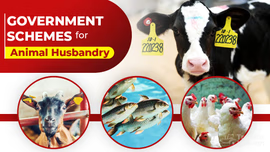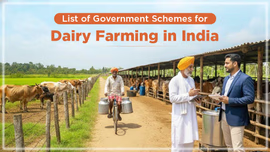Rashtriya Gokul Mission - Preserving the Indigenous Cattle Breeds

Table of Content
- Introduction
- What is Rashtriya Gokul Mission?
- What are the Objectives of Rashtriya Gokul Mission?
- What are the Initiatives Taken Under Rashtriya Gokul Mission?
- What Farmer will Get Under Rashtriya Gokul Mission?
- What is the Impact of Rashtriya Gokul Mission?
- What are the Recent Developments in Rashtriya Gokul Mission?
- How to Avail Benefit Under Rashtriya Gokul Mission?
Introduction
India has the largest bovine population in the world (300 million), out of which 80 per cent are indigenous breeds. It is scientifically established that indigenous breeds, such as Gir and Sahiwal, are disease-resistant, heat-tolerant, and produce good quality milk (rich in fat and solid, not fats). Out of all Indigenous breeds, 80% are low-quality breeds and are domesticated by small and marginal farmers.
To uplift the small & marginal farmers through the genetic upgradation of 11.3 crore low-quality indigenous breeds, the Government of India launched the Rashtriya Gokul Mission.
What is the Rashtriya Gokul Mission?
Rashtriya Gokul Mission (RGM) is a centrally-sponsored scheme to conserve and develop high-quality indigenous cattle breeds to boost bovine productivity and milk production in the country. It was launched in December 2014 with an initial allocation of INR 500 crores.
In 2020, the scheme was revamped, realigned and extended for 5 years from 2021 to 2026, with an allocation of INR 2400 crores. It is being continued as part of the umbrella scheme Rashtriya Pashudhan Vikas Yojana (RPVY).
What are the Objectives of the Rashtriya Gokul Mission?
Using advance technologies to boost milk production and enhance the productivity of low-quality bovines.
Strengthening breeding network and delivering Artificial insemination (AI) services at doorstep of farmers to enhance the coverage of AI.
Promoting the rearing of indigenous cattle & buffalo and their conservation.
Disseminating the use of high genetic merit bulls of indigenous breeds for breeding purposes.
Increasing the remuneration of farmers they get from dairying.
What are the Initiatives Taken Under the Rashtriya Gokul Mission?
Establishing Gokul Grams as an integrated cattle development centre to develop indigenous breeds.
Establishing National Kamdhenu Breeding Centres as Centres of Excellence.
Launching Pashu Sanjivani to identify and trace Indigenous animals with the help of a 12-digit unique identification number.
Establishing a sex-sorted semen facility to produce female calves.
Establishing and strengthening embryo transfer and in-vitro fertilisation centres.
Setting up the National Bovine Genomic Centre for Indigenous Breeds to increase milk production and bovine productivity.
Developing e-pashuhaat portal to connect farmers and breeders regarding the availability of quality bovine germplasm.
Institution of National Gopal Ratna and Kamdhenu Awards to create awareness among farmers.
What Farmer will get under Rashtriya Gokul Mission?
A subsidy of INR 5000 per IVF pregnancy will be made available to participating farmers to promote accelerated breeding.
A subsidy of INR 750 per pregnancy or 50% of the total cost to participating farmers to promote the sex-sorted semen for assured pregnancy.
Organising farmers' training programs and giving awards to farmers to create awareness among farmers.
What is the Impact of the Rashtriya Gokul Mission?
Since the launch of RGM in December 2014 and until the end of FY 2022-23, the following impact is observed:
Increase in milk production by 57.6% from 143.6 MT to 230.60 MT.
Milk production increased at a rate of 5.9%.
The average productivity of bovines increased by 24.3% from 1648.17 kg/animal/year to 2048 kg/animal/year, which is the highest productivity growth rate in the world.
The value of milk output is greater than INR 9.95 lakh crore at the end of 2021-22 (NAS 2023)
What are the Recent Developments in the Rashtriya Gokul Mission?
Union Budget 2024-25 has allocated INR 700 crore to the Rashtriya Gokul Mission for the current financial year.
A 100-day action plan for animal health, dairy and conservation has been envisaged. The action plan will include the Animal Health System Support for One Health, the revamped Rashtriya Gokul Mission, and the National Fodder Mission.
How to Avail Benefits under the Rashtriya Gokul Mission?
The subsidy component to participating farmers under RGM is available for taking up assured pregnancy with sex-sorted semen, therefore, to avail the benefit.
First, the farmers/ beneficiaries must register with the Implementing Agency (IAs).
The mentioned IAs are the State Livestock Development Board (SLDB)/ Department of Animal Husbandry, State Milk Federation/ National Dairy Development Board (NDDB).
Second, the IAs will select the eligible beneficiaries and sign a contract.
Third, upon entering the contract, the farmer will deposit his share of INR 750 per pregnancy (for the first two years of the project) and INR 400 per pregnancy from 3rd year onward.
Frequently Asked Questions On Rashtriya Gokul Mission - Preserving the Indigenous Cattle Breeds
1. What is Rashtriya Gokul Mission (RGM)?
RGM is a scheme to conserve and develop indigenous high-quality bovine breeds in the country so that milk production and profitability of dairy farmers increases in the country.
2. What subsidy will farmers get under assured pregnancy component of RGM?
Participating farmers will get subsidy up to 50% of the total cost for assured pregnancy through sex-sorted semen.


Related Blogs












